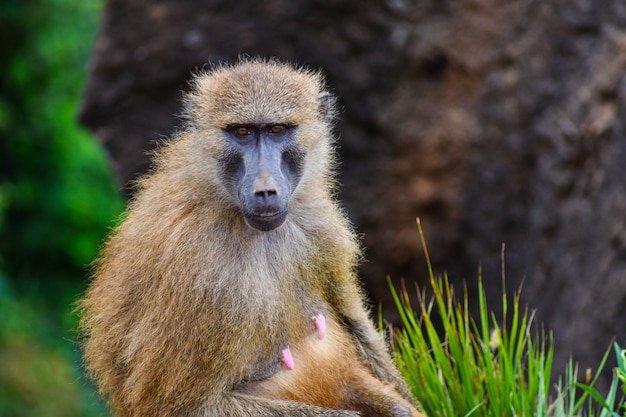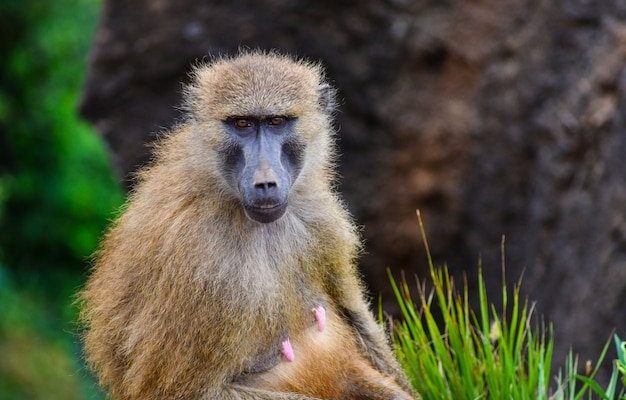
Living primarily in Africa, guinea baboons find themselves in environments that range from dry savannas to rocky, arid regions. Picture a land where water is scarce, temperatures soar during the day, and food sources can be limited. How do these agile primates not only survive but flourish? Let’s dive into the incredible strategies they use to beat the odds, showing us that resilience often means thinking outside the box—and sometimes hanging out in trees!
Understanding the Habitat of Guinea Baboons
To appreciate how guinea baboons survive, we first need to consider their habitat. These primates are versatile, inhabiting grasslands, woodlands, and even some semi-desert regions. Think of it like living in a bustling city versus a quiet countryside—a baboon’s environment influences everything they do.
One of the remarkable adaptations of guinea baboons is their ability to thrive in areas with scarce resources. They often journey several kilometers a day in search of food and water, much like a traveler exploring a new city. This daily trek allows them to cover diverse terrain, from open plains to rocky outcrops, making them skilled navigators of their home.
Guinea baboons have a social structure that groups them into bands. These bands often comprise 20 to 50 individuals. This social interaction is crucial for survival, as they rely on each other for support and protection. Teamwork is their secret weapon against predators, and it’s fascinating to see how these primates communicate and coordinate during their foraging trips.
Foraging Techniques of Guinea Baboons
Feeding is a critical aspect of survival for guinea baboons, and they’ve developed clever techniques to find food. Their diet is omnivorous, consisting of fruits, seeds, roots, and even insects. They’re like nature’s grocery shoppers, always on the lookout for the freshest produce.
One of the most impressive strategies they use is called “scavenging.” When food is scarce, they’ll often follow larger animals, like elephants, to feast on leftovers. Talk about a creative meal plan! Imagine finding a banquet spread on the ground just because you followed a friend—this strategy not only helps them find food but also minimizes competition with other animals.
They also utilize their strong sense of sight to detect food sources from a distance. Their keen eyesight allows them to spot trees heavy with ripe fruits or patches of grass teeming with insects. It’s like having a built-in radar system that helps them make quick decisions about which direction to go.
Water Conservation Strategies
Living in dry environments means that water is a precious resource for guinea baboons. They’ve evolved several tactics to conserve water and stay hydrated. Imagine you’re on a long hike without a water bottle—what would you do? Guinea baboons have mastered the art of hydration.
These clever creatures often find water in unexpected places. They will dig in moist earth to uncover hidden sources or drink from pools left after rainstorms. This behavior is akin to treasure hunting; they know precisely where to look for their “prized finds.”
Moreover, guinea baboons have adapted by developing a low metabolic rate during extreme heat. This means they can withstand long periods without drinking water, allowing them to thrive in harsh climates. Just like a desert plant, they’ve learned to use resources wisely, ensuring survival even when conditions are less than ideal.
Social Structure and Protection
If you’re wondering how guinea baboons protect themselves from predators, the answer lies in their intriguing social dynamics. Their social structure is complex, often resembling a close-knit family. Each member has its role, and they work together to keep their community safe.
When danger approaches, you’ll often see them alerting one another with loud alarm calls. It’s like an emergency meeting where everyone knows their part. Some take on the role of sentinels, standing watch while others forage. This teamwork ensures that they can react quickly to threats, whether it’s a hungry lion lurking nearby or a snake hiding in the grass.
Additionally, their strength lies in numbers. When threatened, they’ll often band together to fend off predators. The sight of dozens of baboons working in unison can be intimidating. It’s a remarkable demonstration of collective strength—reminding us how powerful teamwork can be in overcoming challenges.
Adapting to Climate Change
With the ongoing changes in climate, guinea baboons are also adapting to new challenges. Just as we’ve modified our routines due to shifts in weather patterns, these primates have shown resilience in the face of change. Increased temperatures and altered rainfall patterns require them to be flexible in their foraging and social behaviors.
They’ve been observed changing their travel routes and foraging times to avoid the hottest parts of the day. This adaptability mirrors our own adjustments when dealing with heatwaves. If we’re willing to adapt, why shouldn’t they? By modifying their habits, guinea baboons continue to make the most of their environments.
More interestingly, as human activities encroach on their habitats, these clever animals are learning to navigate urban areas for food. It’s almost like a new chapter in their survival story, showing us that adaptation is not just about enduring but also thriving in the face of new circumstances.
The Role of Guinea Baboons in Their Ecosystem
Beyond their survival, guinea baboons play a crucial role in maintaining the balance of their ecosystems. They’re not just surviving; they’re actively contributing to the health of their environment. When you think about it, it’s a perfect example of interconnectedness in the animal kingdom.
By foraging for fruits and seeds, guinea baboons help with the distribution of plants. They act like nature’s gardeners, promoting growth and ensuring new plants can thrive. This behavior is essential for maintaining biodiversity, which benefits not only them but countless other species too.
Furthermore, as they travel through their habitats, they create pathways that other animals can use. It’s as if they’re carving out trails for fellow creatures, demonstrating how their presence creates opportunities for others. This interconnectedness highlights the importance of every species, reminding us that each has a role to play in the grand scheme of life.
Guinea baboons are remarkable survivors, showcasing the incredible adaptability of nature. From their social structures to clever foraging techniques, they’ve shown us that resilience comes in many forms. Their ability to navigate harsh environments and thrive despite challenges teaches us valuable lessons about teamwork, resourcefulness, and community.
Next time you hear about guinea baboons, remember that they’re not just making it through tough times—they’re doing so with style and a community spirit that many could admire. So, whether you’re teaching your kids about wildlife or just looking to expand your knowledge, take a moment to appreciate these incredible primates and their journey of survival in the wild. It’s a true testament to what it means to adapt and thrive.

